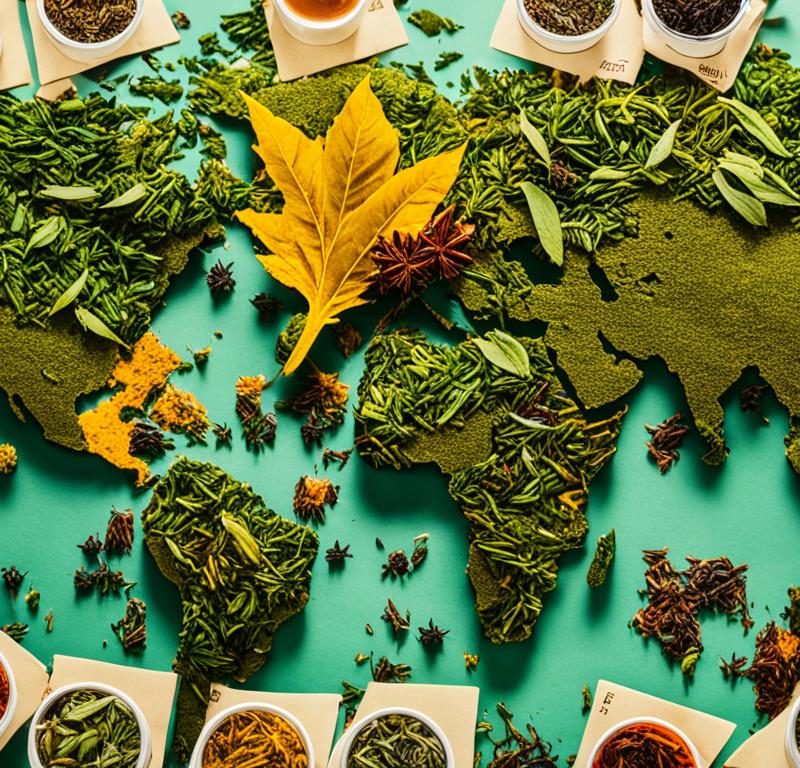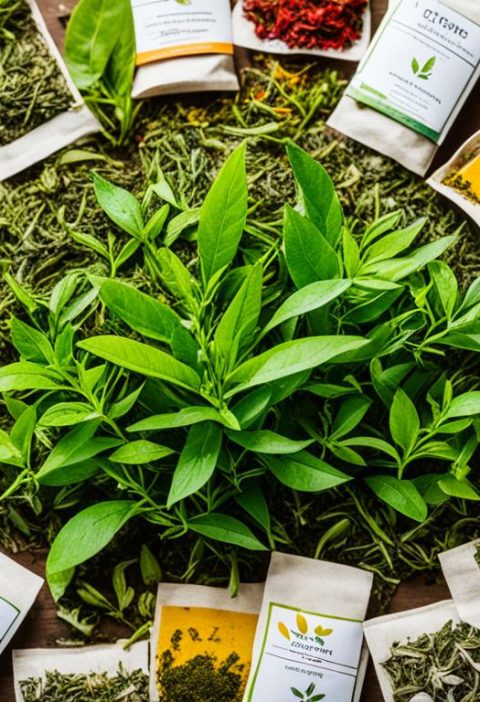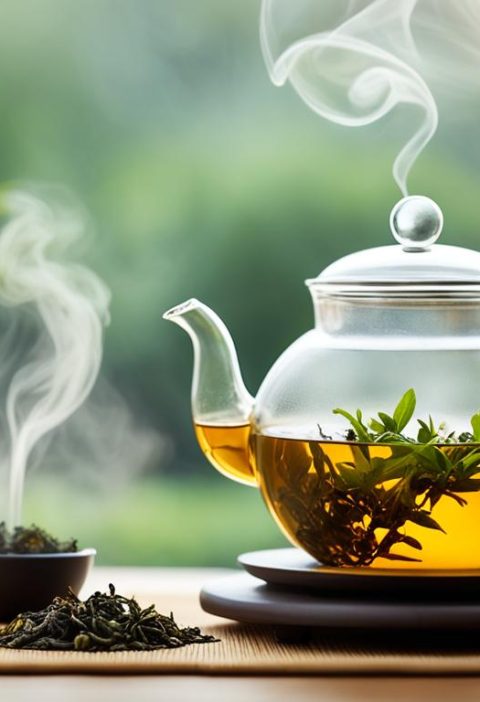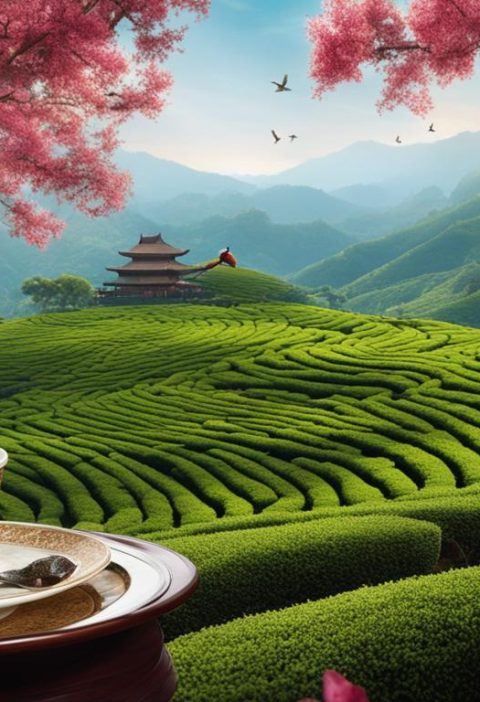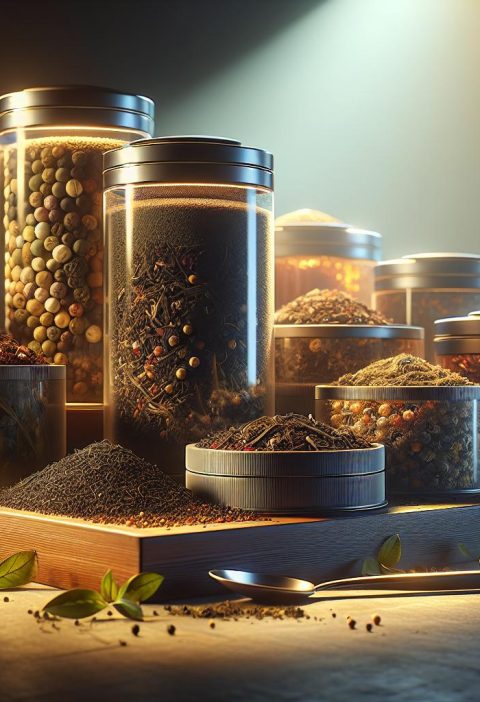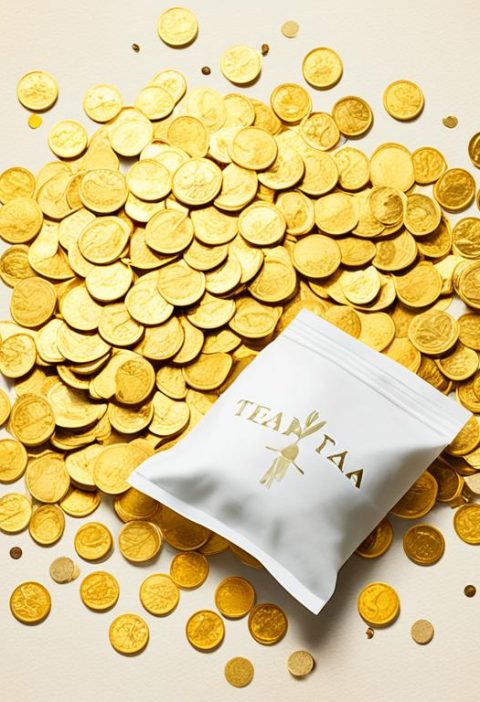Whether you are new to loose leaf tea or have been steeping for a while, it’s important to know the proper way to steep loose leaf teas. This beginner’s guide will take you through the steps to brew the perfect cup of tea every time. From selecting the right tea to determining the steeping time and temperature, you’ll learn all the tips and techniques to become a tea steeping expert. Let’s get started!
Step 1: Select Your Loose Leaf Tea
The first step in steeping loose tea is to select your desired tea. There are various types of loose leaf teas available, including black tea, green tea, rooibos, oolong, white tea, and herbal blends. Consider exploring different tea varieties or try a sampler pack to experience a range of flavors. Premium Steap offers a wide selection of exotic loose leaf teas to choose from.
Step 2: Tea Tools
In order to steep loose tea, you’ll need the right tools. Some common tea brewing tools include a tea infuser, paper filter, tea strainer, tea kettle, or a travel thermos with a built-in infuser. Choose a tool that suits your brewing preferences and ensure that it is thoroughly cleaned before use. Premium Steap offers a range of high-quality tea tools to enhance your tea brewing experience.
Step 3: Hot, Hot, Hot!
The next step is to heat fresh water for steeping your tea. It is important to avoid using a microwave to heat your water as it can affect the taste of the tea. Instead, use a tea kettle to heat the water to the appropriate temperature for your desired tea type. Each tea variety has a recommended water temperature, and following the guidelines will ensure optimal flavor extraction.
Step 4: Measure Your Tea
The amount of tea used for steeping is crucial for achieving the desired taste and strength. As a general rule, use one teaspoon of loose leaf tea per cup of water. However, it is essential to refer to the specific instructions provided on the tea packaging. Adjust the amount of tea according to the size of your mug or teapot to ensure the perfect balance of flavors.
Step 5: Steep Time & Temperature
Steeping time and temperature play a significant role in the flavor profile of your tea. Different tea types require varying steeping durations and water temperatures. Black tea typically requires 3-5 minutes at 212°F, while green tea needs 2 minutes at a lower temperature of 140-180°F. Refer to the specific recommendations for each tea variety to achieve the best results.
Step 6: Enjoy!
Once your tea has steeped, remove the infuser or strain the tea leaves if necessary. It is important to note that some teas, such as oolong, green, and white teas, can be used for multiple infusions. As you become more experienced in tea brewing, you can experiment with variations in quantity, temperature, and steeping time to personalize your cup of tea. Add sweeteners or milk if desired and savor the flavors of your perfectly steeped loose tea.
How to Brew Loose Leaf Tea Without an Infuser
If you don’t have a tea infuser, you can still brew loose leaf tea using alternative methods. Simply place the tea leaves directly into your pot or cup and allow them to steep. To strain the tea, use a small mesh strainer, coffee filter, or colander. This ensures that the tea leaves are removed, preventing over steeping and changes in flavor. Tea balls can also be used, but ensure they are large enough to allow the tea leaves to fully expand.
How to Make Loose Leaf Tea Iced
Loose leaf tea can also be used to make refreshing iced tea. You can either brew hot tea and allow it to cool before refrigerating or cold brew the tea by steeping it directly in cold water overnight. For single servings, brew a smaller amount of hot tea and pour it over ice for immediate enjoyment. Discover the pleasure of sipping a glass of chilled loose leaf tea on a hot day.
How to Store Loose Leaf Tea
To maximize the freshness of your loose leaf tea, store it in an opaque, airtight container in a cool, dark place. Glass jars or sealed plastic bags can also be used as long as they are stored away from light. Proper storage helps preserve the quality and flavor of the tea. Loose leaf tea generally has a shelf life of 6-12 months, so it’s recommended to consume it within a year of purchase. Ensure that your tea collection stays in optimal condition for a delightful tea experience.
Key Takeaways:
- Select your desired loose leaf tea from a variety of options.
- Choose the right tea tools for your brewing preferences.
- Heat fresh water to the appropriate temperature for your tea type.
- Measure your tea accurately for the desired taste and strength.
- Refer to specific steeping guidelines for each tea variety.
- Experiment with variations to personalize your cup of tea.
- Use alternative methods to brew loose leaf tea without an infuser.
- Make refreshing iced tea with loose leaf tea.
- Store loose leaf tea in an airtight container in a cool, dark place.
Step 1: Select Your Loose Leaf Tea
When it comes to steeping loose tea, the first and most crucial step is selecting the right tea for your taste preferences. With a wide variety of options available, it can be overwhelming to choose the perfect tea. Whether you’re a black tea enthusiast or a fan of herbal blends, there is a loose leaf tea that will captivate your taste buds.
To make the selection process easier, consider the different types of loose leaf tea:
- Black tea: Known for its robust flavors and caffeine content, black tea is often paired with breakfast or enjoyed as a bold afternoon pick-me-up.
- Green tea: Loved for its earthy and vegetal flavors, green tea offers a wide range of health benefits. It’s a popular choice for those looking for a lighter caffeine boost.
- Oolong tea: This traditional Chinese tea lies somewhere between black and green tea, presenting a unique blend of floral and fruity flavors.
- White tea: Delicate and subtle, white tea is made from the young leaves and buds of the tea plant. Its light flavor and low caffeine content make it a popular choice for those looking for a soothing cup.
- Rooibos: Often referred to as “red tea,” rooibos is a herbal infusion from South Africa. It has a naturally sweet and nutty flavor and is caffeine-free, making it an excellent option for a relaxing evening drink.
- Herbal blends: These blends incorporate various herbs, fruits, and spices, resulting in a wide range of flavors. From soothing peppermint to tangy hibiscus, herbal blends offer endless possibilities.
Don’t be afraid to step out of your comfort zone and explore exotic loose leaf tea varieties. Trying different teas is an exciting way to expand your palate and discover new favorites.
At Premium Steap, we offer an extensive selection of high-quality loose leaf teas sourced from around the world. From rare single-origin teas to carefully crafted blends, our collection is sure to satisfy even the most discerning tea lover.
Tantalizing Tea Varieties at Premium Steap
| Tea Type | Flavor Profile | Origin | Caffeine Content |
|---|---|---|---|
| Assam Black Tea | Rich, malty, and full-bodied | India | High |
| Dragon Well Green Tea | Mellow with a slightly nutty aroma | China | Low |
| Tie Guan Yin Oolong Tea | Floral, sweet, and complex | Taiwan | Moderate |
| Silver Needle White Tea | Delicate, sweet, and floral | China | Low |
| Rooibos Chai | Warm, spicy, and invigorating | South Africa | Caffeine-free |
| Chamomile Lavender Herbal Blend | Soothing, floral, and calming | Various | Caffeine-free |
Step 2: Tea Tools
In order to steep loose tea, you’ll need the right tools. Having the proper tea brewing tools makes the process easier and ensures a delicious cup of tea. Here are some essential tools for steeping loose tea:
1. Tea Infuser
A tea infuser is a device that holds loose tea leaves while they steep in hot water. It allows the flavors to infuse into the water while preventing any loose leaves from escaping into the tea. There are various types of tea infusers available, such as stainless steel mesh infusers, tea balls, and tea baskets. Choose one that suits your preferences and makes the steeping process convenient.
2. Tea Strainer
A tea strainer is used to strain the brewed tea, separating the tea leaves from the liquid. It ensures a smooth and enjoyable tea-drinking experience by preventing any unwanted residue from entering your cup. Tea strainers are often made of fine mesh or stainless steel and come in different sizes and shapes. Consider using a strainer that fits well over your tea mug or teapot to strain the tea effectively.
3. Tea Kettle
A tea kettle is an essential tool for heating water to the ideal temperature for steeping your loose tea. It allows you to control the heat and ensure that the water reaches the recommended temperature range for different tea types. Electric kettles are convenient and efficient, but stovetop kettles work just as well. Choose a kettle that suits your brewing needs and preferences.
4. Tea Infuser Travel Thermo
If you enjoy tea on the go, a travel thermos with a built-in tea infuser is a great investment. It allows you to steep your loose tea and keep it warm for an extended period. This is particularly useful for tea enthusiasts who want to enjoy their favorite blends while commuting or traveling. Look for a travel thermos that is portable, leak-proof, and made from high-quality materials to ensure that your tea stays hot and flavorful.
| Tea Brewing Tools | Description |
|---|---|
| Tea Infuser | A device that holds loose tea leaves while they steep in hot water, preventing leaves from escaping into the tea. |
| Tea Strainer | Used to strain the brewed tea, separating the tea leaves from the liquid for a smooth tea-drinking experience. |
| Tea Kettle | An essential tool for heating water to the appropriate temperature for steeping loose tea. |
| Tea Infuser Travel Thermo | A portable thermos with a built-in tea infuser, allowing you to steep and enjoy tea on the go. |
Choose the tea brewing tools that align with your personal taste and brewing preferences. Premium Steap offers a wide range of high-quality tea tools, including tea infusers, strainers, kettles, and travel thermos options, to elevate your tea brewing experience. With the right tools at your disposal, you’ll be well-equipped to steep loose tea like a pro.
Step 3: Hot, Hot, Hot!
The next step in steeping loose tea is to heat fresh water to the ideal temperature for brewing. It’s crucial to pay attention to the water temperature as it greatly influences the taste and aroma of your tea. Avoid using a microwave for boiling water as it can give your tea an off-flavor and uneven heat distribution.
To ensure the perfect water temperature for your tea, we recommend using a tea kettle. A tea kettle allows you to heat the water to the precise temperature required for different tea varieties. This way, you can extract the maximum flavor from your loose leaf tea and enjoy a delightful cup every time.
The Importance of Water Temperature
The water temperature affects the extraction of flavors and compounds from the tea leaves. Too hot, and your tea may become bitter or astringent. Too cold, and the flavors may not fully develop. Each type of tea has its own recommended water temperature for steeping, which brings out its unique characteristics and ensures a well-balanced brew.
Here’s a guide to the optimal water temperatures for different tea types:
| Tea Type | Water Temperature |
|---|---|
| Green Tea | 160-180°F/70-82°C |
| Black Tea | 200-212°F/93-100°C |
| Oolong Tea | 190-200°F/88-93°C |
| White Tea | 160-180°F/70-82°C |
| Herbal Tea | 200-212°F/93-100°C |
By using the appropriate water temperature, you can fully experience the nuanced flavors and aromas that each tea has to offer.
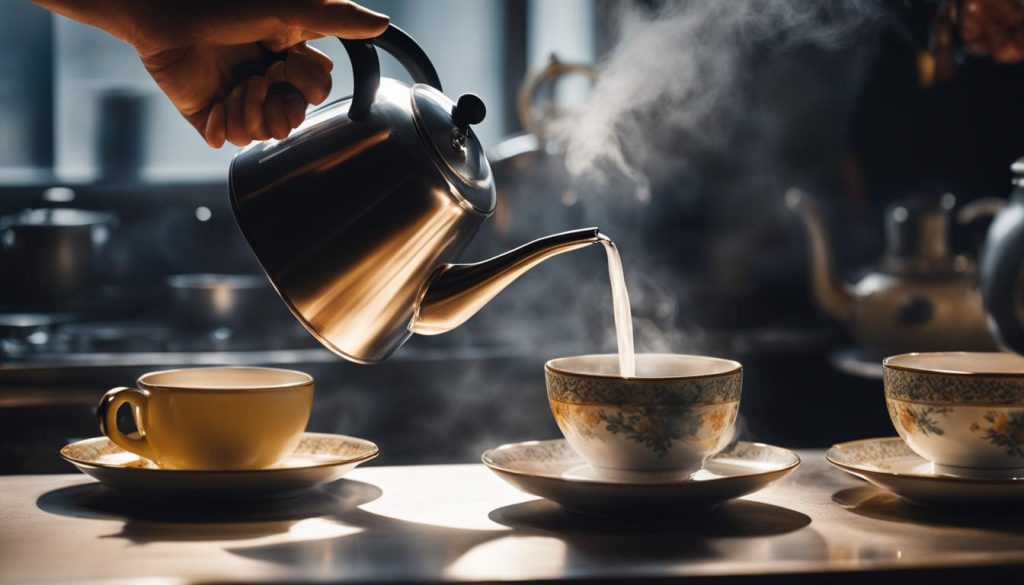
To further enhance your tea brewing experience, invest in a high-quality tea kettle that allows you to set and maintain the desired water temperature. These kettles often come with built-in temperature control and presets for different types of tea, ensuring consistent results with every brew.
Now that we have our hot water ready, let’s move on to the next step: measuring your loose leaf tea.
Step 4: Measure Your Tea
The amount of tea used for steeping is crucial for achieving the desired taste and strength. To ensure the perfect balance of flavors, it’s important to measure your loose leaf tea accurately. Here’s how:
- General Rule: As a starting point, use one teaspoon of loose leaf tea per cup of water.
- Refer to Packaging: Always check the specific instructions provided on the tea packaging for recommended measurements.
- Cup Size: Adjust the amount of tea according to the size of your mug or teapot.
By following these guidelines, you’ll have a well-balanced cup of tea that suits your taste preferences every time.
Here’s a visual representation of the tea to water ratio for different cup sizes:
| Cup Size | Amount of Loose Leaf Tea | Water Volume |
|---|---|---|
| Small (6-8 oz) | 1 teaspoon | 6-8 oz |
| Medium (10-12 oz) | 1.5 teaspoons | 10-12 oz |
| Large (14-16 oz) | 2 teaspoons | 14-16 oz |
Remember, these measurements are just a starting point. Feel free to adjust the amount of tea according to your personal preference. Experimentation is key to finding the perfect tea to water ratio that suits your taste buds.
Step 5: Steep Time & Temperature
Steeping time and temperature are crucial factors in achieving the perfect cup of tea. Each tea type has specific steeping guidelines that bring out its unique flavors and characteristics. It is important to follow these guidelines to ensure the best possible taste. Here are some general recommendations for steeping time and water temperature for different tea types:
Black Tea:
Steeping Time: 3-5 minutes
Water Temperature: 212°F (100°C)
Green Tea:
Steeping Time: 2 minutes
Water Temperature: 140-180°F (60-82°C)
Oolong Tea:
Steeping Time: 3-5 minutes
Water Temperature: 180-205°F (82-96°C)
White Tea:
Steeping Time: 2-3 minutes
Water Temperature: 160-180°F (71-82°C)
Herbal Tea:
Steeping Time: 5-7 minutes
Water Temperature: 212°F (100°C)
These are general guidelines, and each tea may have slightly different recommendations. Always refer to the specific instructions provided by the tea manufacturer for the best results.
| Tea Type | Steeping Time | Water Temperature |
|---|---|---|
| Black Tea | 3-5 minutes | 212°F (100°C) |
| Green Tea | 2 minutes | 140-180°F (60-82°C) |
| Oolong Tea | 3-5 minutes | 180-205°F (82-96°C) |
| White Tea | 2-3 minutes | 160-180°F (71-82°C) |
| Herbal Tea | 5-7 minutes | 212°F (100°C) |
Following the recommended steeping time and water temperature will result in a perfectly brewed cup of tea that brings out the optimal flavors and aromas. Experimenting with different steeping times and temperatures can also be a fun way to personalize your tea experience. Enjoy your cup of tea!
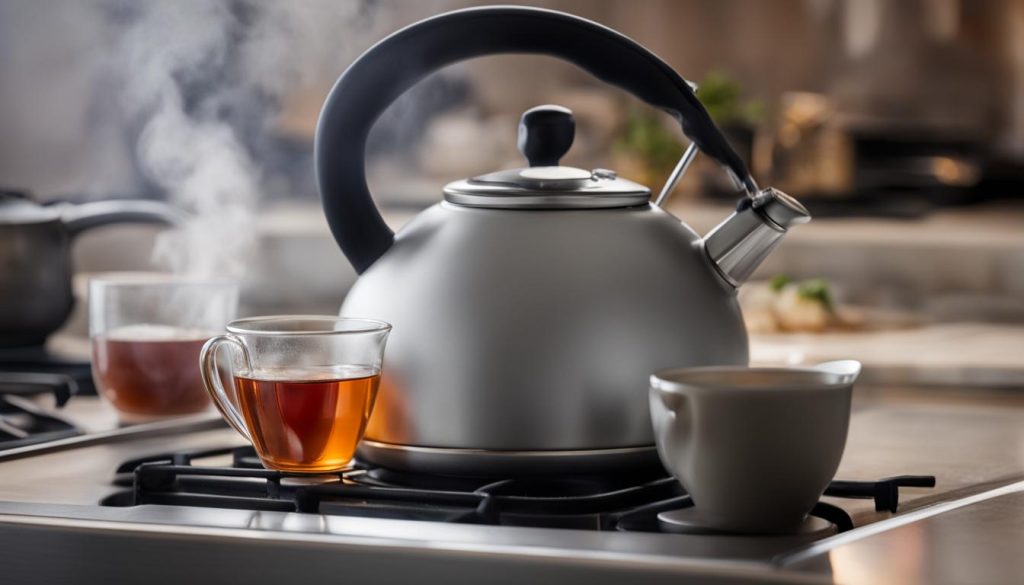
Step 6: Enjoy!
Now that your tea has steeped to perfection, it’s time to sit back, relax, and savor the flavors of your perfectly brewed loose leaf tea. Here are a few ways to enhance your tea-drinking experience:
Experiment with Tea Brewing Preferences
As you become more experienced in tea brewing, don’t be afraid to experiment with different brewing preferences. Adjust the quantity of tea leaves, water temperature, and steeping time to find the perfect balance of flavors that suit your taste buds. Whether you prefer a stronger brew or a lighter infusion, exploring and personalizing your tea brewing routine can elevate your enjoyment of loose leaf tea.
Adding Sweeteners to Tea
For those who enjoy a touch of sweetness in their tea, consider adding natural sweeteners like honey, agave syrup, or sugar to enhance the flavors. Be mindful of the type of sweetener you choose, as some may overpower the delicate nuances of certain teas. Experiment with different sweeteners and their quantities to find the perfect level of sweetness that complements your brew.
Types of Sweeteners for Tea
| Sweetener | Description | Best Tea Pairings |
|---|---|---|
| Honey | A natural, viscous sweetener with a unique flavor profile. Known for its soothing and immune-boosting properties. | Black tea, herbal blends |
| Agave Syrup | A plant-based sweetener with a mild and neutral taste. Dissolves easily in hot or cold liquids. | Green tea, white tea |
| Sugar | A classic sweetener that adds a subtle sweetness. Consider using raw or demerara sugar for a more nuanced flavor. | Chai tea, flavored blends |
Image: Enjoying a Steeped Cup of Tea
Remember, taste preferences vary, so feel free to adjust the sweeteners according to your liking. Some enjoy their tea as is, allowing the natural flavors to shine through.
Take your time while sipping your cup of tea, and appreciate the comforting aroma and soothing warmth as it brings a moment of tranquility to your day. Whether you enjoy it in the morning, as an afternoon pick-me-up, or as a calming ritual before bed, the pleasure of a well-steeped cup of loose leaf tea is unmatched.
How to Brew Loose Leaf Tea Without an Infuser
If you don’t have a tea infuser, don’t worry! There are alternative methods for brewing loose leaf tea without an infuser. Follow these simple steps to enjoy a delicious cup of tea:
Method 1: Placing Tea Leaves Directly into the Pot
- Measure the desired amount of loose leaf tea according to your taste preferences.
- Place the tea leaves directly into your teapot or cup.
- Add hot water at the recommended temperature for your tea type.
- Allow the tea leaves to steep for the recommended time.
- To strain the tea, use a small mesh strainer, coffee filter, or colander. This will ensure that the tea leaves are removed, preventing oversteeping and changes in flavor.
Method 2: Using a Tea Ball
- Select a tea ball that is large enough to allow the tea leaves to fully expand and infuse flavors.
- Fill the tea ball with the desired amount of loose leaf tea.
- Place the tea ball into your teapot or cup.
- Add hot water at the recommended temperature for your tea type.
- Allow the tea leaves to steep for the recommended time.
- Remove the tea ball and enjoy your perfectly brewed loose leaf tea.
Remember, the key to brewing loose leaf tea without an infuser is to ensure that the tea leaves are properly strained. This way, you can avoid oversteeping and achieve a delicious cup of tea every time.
Check out this visually appealing and relevant image related to brewing loose leaf tea without an infuser:
Take a look at this comprehensive table comparing different methods for brewing loose tea:
| Method | Pros | Cons |
|---|---|---|
| Placing Tea Leaves Directly into the Pot | – Simple and convenient – No additional tools required |
– May require straining the tea leaves – Limited control over infusion |
| Using a Tea Ball | – Easy to use – Keeps tea leaves contained |
– Limited space for tea leaves to expand – May affect flavor infusion |
How to Make Loose Leaf Tea Iced
Loose leaf tea is not limited to just hot beverages. You can also use it to make refreshing iced tea that’s perfect for those hot summer days. There are two methods you can use to achieve a delicious glass of iced tea: brewing hot tea and allowing it to cool, or cold brewing the tea directly in cold water. Let’s explore both methods:
Brewing Hot Tea and Cooling Method
1. Start by steeping your loose leaf tea in hot water, following the guidelines for water temperature and steeping time based on the type of tea.
2. Once the tea is brewed to your desired strength, remove the infuser or strain the tea leaves.
3. Allow the hot tea to cool to room temperature.
4. After the tea has cooled, transfer it to a pitcher and refrigerate it until chilled.
5. Serve the iced tea over ice cubes and enjoy!
Cold Brewing Method
1. Add loose leaf tea to a pitcher or container.
2. Fill the container with cold water, using a ratio of 1 teaspoon of tea leaves per cup of water.
3. Give the tea a gentle stir to ensure all the leaves are fully immersed in the water.
4. Cover the container and refrigerate it overnight, allowing the tea to cold brew.
5. The next day, strain out the tea leaves or remove the infuser.
6. Serve the cold-brewed tea over ice cubes and enjoy!
| Method | Procedure |
|---|---|
| Brewing Hot Tea and Cooling Method | 1. Steep loose leaf tea in hot water 2. Remove infuser or strain the tea leaves 3. Allow hot tea to cool to room temperature 4. Refrigerate until chilled 5. Serve over ice |
| Cold Brewing Method | 1. Add loose leaf tea to a container 2. Fill with cold water 3. Stir gently 4. Refrigerate overnight 5. Strain or remove infuser 6. Serve over ice |
Both methods result in a refreshing glass of iced tea with a smooth and rich flavor. Feel free to experiment with different tea varieties and add fruits or herbs to create your own signature iced tea blends. Take a moment to savor the cool and invigorating taste of loose leaf tea on a warm day.
How to Store Loose Leaf Tea
Properly storing your loose leaf tea is essential for maintaining its freshness and flavor. To maximize the longevity of your tea, we recommend following these simple tea storage techniques:
1. Use an opaque, airtight container: Transfer your loose leaf tea from its original packaging to a container that blocks out light. This helps to preserve the tea’s delicate flavors and prevents it from absorbing odors from the surroundings.
2. Keep it in a cool, dark place: Store your tea in a cool and dry area, away from direct sunlight or heat sources. Avoid storing it near stovetops or in cabinets near appliances that emit heat. The ideal temperature for tea storage is around 60-70°F (15-21°C).
3. Glass jars or sealed plastic bags: If you prefer using glass jars or ziplock bags, make sure they are airtight and lightproof. These alternatives can be a good option to keep your loose leaf tea fresh, as long as they are stored in a cool, dark place.
By following these proper tea storage techniques, you can ensure that your loose leaf tea remains fresh and flavorful for a longer period. Remember, loose leaf tea has a shelf life of 6-12 months, so it’s best to consume it within a year of purchasing for the best taste experience. So go ahead and savor every sip of your carefully stored loose leaf tea!
